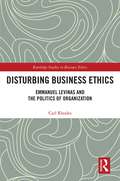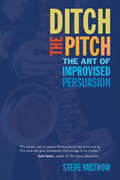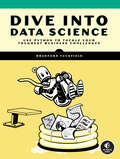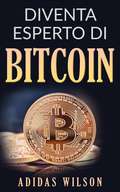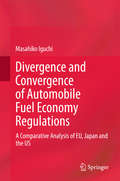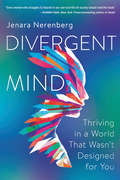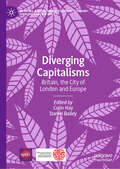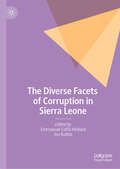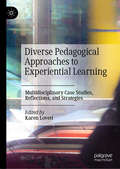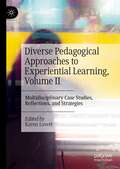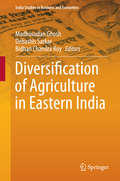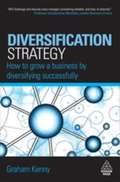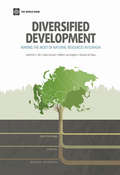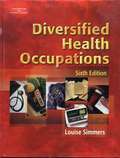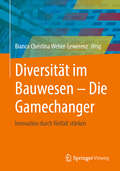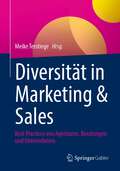- Table View
- List View
Disturbing Business Ethics: Emmanuel Levinas and the Politics of Organization (Routledge Studies in Business Ethics)
by Carl Rhodes21st century Western neoliberalism has seen the transformation of self-interest from an economic imperative to a centrally constitutive part of dominant modes of subjective existence. Against this celebration of competitive individualism, Emmanuel Levinas’ philosophy stands as a haunting reminder of an ethics that passively disturbs the self from its egoistic slumber, awakening it to the incessant demands of the other. Ethics stands as an anxious affective state of being where one is held to account by others, each one demanding care, attention and respect. Focussing on business activities and organizations, this book explores how this ethical demand of being for the other becomes translated, in a necessarily impure way, into political action, contestation and resistance. Such a response to ethics invokes a disturbance of organizational order, including an order that might itself be labelled ‘ethical’. On these grounds, the book offers an explication of an ethics for organizations which disturbs the selfishness of neoliberal morality, and can inform a democratic politics rested on a genuine concern for the other and for justice. Disturbing Business Ethics: Emmanuel Levinas and the Politics of Organization offers an unconventional and enlightening approach to ethical thinking and practice in politics and organisations, and will be of interest to students of business, management, leadership, political science and organizational theory.
Ditch the Pitch
by Steve YastrowIn today's world, customers don't want to hear sales pitches, but so many salespeople still rely on them. In his breakthrough handbook, Ditch the Pitch, Steve Yastrow, founder of a successful business strategy consulting firm, asks us to throw out everything we've been taught about pitching to customers. Steve's advice: tear up your sales pitch and instead improvise persuasive conversations. Ditch the Pitch is an essential read for salespeople, business managers, and anyone wishing to persuade those around them. Organized into six habits, with each habit consisting of three practices necessary for mastery, Ditch the Pitch is designed to teach Yastrow's approach to fresh, spontaneous, persuasive conversations. These new skills will show the reader how to identify the details that make each customer unique and subsequently navigate a conversation that focuses on the right message for the right customer at the right time. Throughout the book, the author quotes well-known improv comedians and musicians. He translates the techniques these artists use when improvising to create persuasive situations with customers. With the new confidence Ditch the Pitch offers, you will become master of the art of on-the-spot, engaging, and effective customer interactions. Let go of pre-written scripts and embrace Yastrow's guidelines for effortlessly enabling spontaneous conversations that persuade customers to say "yes. "
Ditch the Pitch: The Art of Improvised Persuasion
by Steve YastrowIn today's world, customers don't want to hear sales pitches, but so many salespeople still rely on them. In his breakthrough handbook, Ditch the Pitch, Steve Yastrow, founder of a successful business strategy consulting firm, asks us to throw out everything we've been taught about pitching to customers. Steve's advice: tear up your sales pitch and instead improvise persuasive conversations. Ditch the Pitch is an essential read for salespeople, business managers, and anyone wishing to persuade those around them. Organized into six habits, with each habit consisting of three practices necessary for mastery, Ditch the Pitch is designed to teach Yastrow's approach to fresh, spontaneous, persuasive conversations. These new skills will show the reader how to identify the details that make each customer unique and subsequently navigate a conversation that focuses on the right message for the right customer at the right time.
The DivaCup: Navigating Distribution and Growth
by Ayelet IsraeliWhen the mother-daughter founders of DivaCup set out with a mission to disrupt the menstrual care industry with an innovative product form, they initially struggled to gain legitimacy and convince retailers to carry their unique product. Now, fifteen years later, the product was available online and in more than 35,000 retail stores worldwide, and the company was struggling with omnichannel distribution challenges and frequent violations of their pricing policy due to intense competition among channel partners. International distribution and the prevalence of gray market sellers were causing large price dispersions across markets, which was harming the brand further. In October 2018, the entry of a formidable competitor, P&G (owner of menstrual care brands Tampax and Always), into the niche product segment causes the CEO and her team to consider the best plan to reposition and differentiate its product to broaden its appeal to users of other product forms, while maintaining its market leadership in the menstrual cup segment. This challenge is made more difficult due to prevalent miseducation about menstrual care and menstrual cups in particular.
Dive Into Data Science: Use Python To Tackle Your Toughest Business Challenges
by Bradford TuckfieldLearn how to use data science and Python to solve everyday business problems.Dive into the exciting world of data science with this practical introduction. Packed with essential skills and useful examples, Dive Into Data Science will show you how to obtain, analyze, and visualize data so you can leverage its power to solve common business challenges.With only a basic understanding of Python and high school math, you&’ll be able to effortlessly work through the book and start implementing data science in your day-to-day work. From improving a bike sharing company to extracting data from websites and creating recommendation systems, you&’ll discover how to find and use data-driven solutions to make business decisions.Topics covered include conducting exploratory data analysis, running A/B tests, performing binary classification using logistic regression models, and using machine learning algorithms.You&’ll also learn how to:Forecast consumer demand Optimize marketing campaignsReduce customer attritionPredict website trafficBuild recommendation systemsWith this practical guide at your fingertips, harness the power of programming, mathematical theory, and good old common sense to find data-driven solutions that make a difference. Don&’t wait; dive right in!
Diventa esperto di Bitcoin
by Adidas Wilson Andrea GiampaoliIl Bitcoin è una criptovaluta ed un sistema di pagamento digitale ideato da uno sviluppatore sconosciuto, o da un gruppo di sviluppatori sotto il nome di Satoshi Nakamoto. Venne pubblicato come software open-source nel 2009. Il sistema è peer-to-peer e le transazioni vengono effettuate direttamente tra gli utenti, senza un intermediario. Queste transazioni vengono in seguito verificate dai nodi del network e registrate in un libro contabile pubblico chiamato blockchain. Poiché il sistema funziona senza un database centrale o un amministratore, il Bitcoin viene definito come la prima valuta digitale decentralizzata. Oltre ad essere creato come premio per il mining, il Bitcoin può essere scambiato con altre valute, prodotti e servizi nei mercati legali o nei mercati di contrabbando. Nel Febbraio 2015 oltre 100.000 commercianti e venditori accettavano pagamenti in Bitcoin. Secondo una ricerca dell'Università di Cambridge pubblicata nel 2017, ci sono da 2.9 a 5.8 milioni di utenti che usano un portafoglio di criptovalute, e la maggior parte di essi usano i Bitcoin.
Divergence and Convergence of Automobile Fuel Economy Regulations
by Masahiko IguchiThis book reveals the mechanisms underlying the convergence of car fuel economy regulations in Europe, Japan and the US by drawing upon a constructivist theory of International Relations and law that focuses on business competition and environmental regulations. It offers new understanding of the topic of cars and an issue of climate change, discussing the emerging phenomenon of convergence of fuel economy regulations; addressing the role of business actors in pushing for climate change action; proposing the new model of agency with and beyond states; and providing insightful case studies from Europe, Japan and the US. The opening chapter reviews the automobile industry and global climate change, providing a background for the discussion to follow. Chapter 2, Business Actors and Global Environmental Governance, grounds the discussion in the field of environmental governance. The third chapter is a case study examining the construction and timing of the European Union's climate policies for automobile CO2 emissions, discussing the underlying factors and the actors influencing the policies. The following chapter argues that Japan adopted its stringent fuel economy regulations primarily because of industry competitiveness, motivated by stringent environmental regulations in export markets and encouraged by a tradition of 'co-regulation' and 'corporatism' to enhance the regulations. Chapter 5 asks why the US, the first country to introduce fuel economy regulations, spent two decades in regulatory stagnation, and discusses how recent US fuel economy regulations came to converge with Japanese and European standards. Chapter 6 compares, contrasts and analyzes fuel economy regulations among the three case studies and identifies policy implications for the future climate governance for 2015 and beyond. The final chapter explores applicability of the 'agency with and beyond the state' model to other sectors and to climate governance as a whole.
Divergent Mind: Thriving in a World That Wasn't Designed for You
by Jenara NerenbergAUDIBLE EDITOR'S PICKA paradigm-shifting study of neurodivergent women—those with ADHD, autism, synesthesia, high sensitivity, and sensory processing disorder—exploring why these traits are overlooked in women and how society benefits from allowing their unique strengths to flourish.As a successful Harvard and Berkeley-educated writer, entrepreneur, and devoted mother, Jenara Nerenberg was shocked to discover that her “symptoms”--only ever labeled as anxiety-- were considered autistic and ADHD. Being a journalist, she dove into the research and uncovered neurodiversity—a framework that moves away from pathologizing “abnormal” versus “normal” brains and instead recognizes the vast diversity of our mental makeups. When it comes to women, sensory processing differences are often overlooked, masked, or mistaken for something else entirely. Between a flawed system that focuses on diagnosing younger, male populations, and the fact that girls are conditioned from a young age to blend in and conform to gender expectations, women often don’t learn about their neurological differences until they are adults, if at all. As a result, potentially millions live with undiagnosed or misdiagnosed neurodivergences, and the misidentification leads to depression, anxiety, low self-esteem, and shame. Meanwhile, we all miss out on the gifts their neurodivergent minds have to offer.Divergent Mind is a long-overdue, much-needed answer for women who have a deep sense that they are “different.” Sharing real stories from women with high sensitivity, ADHD, autism, misophonia, dyslexia, SPD and more, Nerenberg explores how these brain variances present differently in women and dispels widely-held misconceptions (for example, it’s not that autistic people lack sensitivity and empathy, they have an overwhelming excess of it).Nerenberg also offers us a path forward, describing practical changes in how we communicate, how we design our surroundings, and how we can better support divergent minds. When we allow our wide variety of brain makeups to flourish, we create a better tomorrow for us all.
Diverging Capitalisms: Britain, the City of London and Europe (Building a Sustainable Political Economy: SPERI Research & Policy)
by Daniel Bailey Colin HayThis book analyses the changing nature of the British economy and the consequences of Brexit upon its place within the European economic space. The overhang from the global financial crisis, the Eurozone crisis, the political negotiation of prolonged economic downturn and now the spectre of ‘Brexit’ provide the backdrop for various forms of capitalist restructuring designed to restore competitiveness and prosperity. This re-structuring has clear implications for existing European growth models, the structural imbalances and inequalities which characterise the British economy, the fortunes of the City of London and competing financial districts internationally, and the prospective strategies of progressive politics in this context. Adopting a broadly critical political economy lens – which gives analytical weight to the relationship between economic and political dynamics – the book will draw on the research of eminent scholars to assess divergence in the foundations of economic competitiveness and their social repercussions.
Diverging Destinies
by James M. Raymo Miho IwasawaThe overarching objective of this book is to summarize, extend, and update previous research on educational differences in family behavior in Japan. This is the first comprehensive treatment of the subject and the first to evaluate family differentials in Japan in the context of ideas articulated in research on "diverging destinies" and "patterns of disadvantage" as part of the second demographic transition. Much of the previous work in this area has been conducted by the authors (Raymo and Iwasawa), and the longer format of this book allows us to reexamine a wide range of family outcomes using newer data and to provide a thorough and systematic evaluation. The text uses multiple sources of data that cover a period of rapid family change (1970s through 2010s) to describe trends in educational differences in a wide range of family behaviors linked to the well-being of both parents and children. Descriptive analyses provide an overview of period and cohort trends in educational differences in age at first marriage, assortative mating, cohabitation, bridal pregnancy, divorce, remarriage, age at first birth, unintended childbearing, single motherhood, maternal employment, and family-related attitudes. Multivariate analyses provide insights into the processes underlying observed educational differences in family behavior. Patterns of educational differences in family behavior in Japan are evaluated with reference to findings from related research in the United States and other low-fertility Western societies.
The Diverse and Demanding New Workforce: Why You Need a New Workforce Strategy
by Ken Dychtwald Tamara J. Erickson Robert MorisonWe cannot avoid skills and worker shortages entirely, but these shortages are inevitable only for organizations that fail to anticipate workforce changes and adjust in time. This chapter outlines today's increasingly diverse workforce, emphasizing that the management techniques needed to accommodate tomorrow's labor market can be applied now to improve business performance, cost structures, and employee retention.
The Diverse Facets of Corruption in Sierra Leone
by Ina Kubbe Emmanuel Saffa AbdulaiThis edited volume delves into Sierra Leone’s complex post-conflict landscape. It posits that the nation’s path to peace and stability hinges on robust anticorruption measures. The chapters explore Sierra Leoneans’ unique perception of corruption, reflecting its political, economic, legal and socio-cultural dimensions. Moving away from mere theoretical abstraction, the book pulls together fascinating practical discussions on the success and challenges of anti-corruption tools used in Sierra Leone. Approaches used to explain corruption in this postwar fragile democratic country include issues like non-conviction-based asset recovery and how it works; unexplained wealth exposes lifestyle offences, accountability of the judiciary and how judicial institutions can become a predator; the role of the media in the fight against corruption; the part of culture and history in engraining corruption; patrimonialism as an explanation of corruption; ad social norms and sociological exposition to explain corruption.
Diverse Hydrogen Sources for Biomass-derivatives Conversion: Reaction and Mechanism
by Zhibao HuoThe book covers advances in conversion of biomass and derivatives into useful chemicals and fuels. It describes our recent researches relating to the hydrogenation of biomass derivatives by diverse hydrogen sources such as water, isopropanol, gaseous hydrogen and NaBH4 as well as their interesting mechanism aspects. A wide range of biomass derivatives and some novel hydrogenation processes are involved in this book. Development strategies and challenges in future research are also discussed. This book will help readers to expand their knowledge of biomass and its derivatives conversion.
Diverse Pedagogical Approaches to Experiential Learning: Multidisciplinary Case Studies, Reflections, and Strategies
by Karen LovettThis edited collection offers a unique multidisciplinary perspective into the many factors that go into designing, facilitating, expanding, and assessing experiential learning (EL) from the perspective of faculty and staff educators. The editor and contributors bring decades of expertise with different forms of EL, including community-engaged learning, education abroad, internships, and more. Chapters offer case studies and reflections which highlight personal experiences and anecdotes which illuminate the realities of experiential teaching and learning. Through these stories and narratives, readers may better understand what doing EL entails on an everyday basis—both on a local and global scale—and learn how to enhance support and resources for experiential educators on college and university campuses.
Diverse Pedagogical Approaches to Experiential Learning, Volume II: Multidisciplinary Case Studies, Reflections, and Strategies
by Karen LovettThis second volume of Diverse Pedagogical Approaches to Experiential Learning (Palgrave, 2020) contains a new collection of experiential learning (EL) reflections, case studies, and strategies written by twenty-eight authors across sixteen academic disciplines. Like the first volume, the chapters describe the process of developing, implementing, facilitating, expanding, and assessing EL in courses, programs, and centers both locally and globally. The authors take on new themes in this collection, including discussions on the intersections of experiential learning with race and privilege, cross-cultural competencies, power and gender, professional development and vocational discernment, self-inquiry and reflection, social justice, and more. The authors also address the importance of adapting new pedagogical approaches to EL in response to challenges in higher education presented by the global coronavirus pandemic.
Diversification of Agriculture in Eastern India
by Madhusudan Ghosh Debashis Sarkar Bidhan Chandra RoyDivided into three parts - Rationale and Extent of Agricultural Diversification, Nature and Problems of Agricultural Diversification, and Food and Livelihood Security through Agricultural Diversification, this edited book examines various aspects of agricultural diversification in Eastern India. In recent years, Indian agriculture has been diversifying from cereals to high-value crops and livestock products in accordance with the changing consumption patterns. As such, it faces the challenges of a new economic regime, besides the usual problems of rising population, unemployment and poverty, declining investments in the agriculture sector and degradation of natural resources. These issues are discussed in the book in light of the significant transformation in the economic structure of the Indian economy from agriculture to non-agriculture (industry and services) and changing cropping pattern from cereals to non-cereals, in accordance with the changing consumption pattern. The book would be of interest to teachers, researchers, policymakers, students and general readers having an interest in agricultural development in India.
Diversification Strategy: How To Grow A Business By Diversifying Successfully
by Graham KennyDiversified organizations are everywhere - in the private, public and not-for-profit sectors. With diversification comes complication, and if the varied activities of these organizations are not carried out effectively, their very diversity can lead to major inefficiency at best and corporate failure at worst. Diversification Strategy challenges conventional wisdom and establishes a blueprint for successfully managing diversification. Using illuminating case studies such as General Electric, Wesfarmers, Bidvest, ITC and Burns Philip - it analyses the whole process in detail, and describes the seven characteristics of successful diversifiers. Through examining what successful and unsuccessful diversifiers do, as well as the effective practices of focused firms, it provides best-practice guidance for successfully managing diversified organizations and the business units within them. Whether private sector, public sector or not-for-profit, all organizations will all benefit from understanding and applying the principles outlined in this indispensible guide to diversification strategy.
Diversification, the Capital Asset Pricing Model, and the Cost of Equity Capital
by David W. Mullins Jr.Describes in nonmathematical terms the nature of capital asset pricing model and possible use in estimating a company's cost of equity capital.
Diversified Development
by Indermit S. Gill Ivailo Izvorski Willem Van Eeghen Donato De RosaDevelopment policy discussions in Eurasia often become debates about how economies can be made more diversified. For a region that is resource-rich, this is to be expected. But Eurasian economies have in many ways become less diversified during the past two decades. At the same time, people are much better off today than they were in the 1990s: poverty has been cut in half, incomes have increased fivefold, and education and health have improved noticeably since the tumultuous days following the collapse of communism. Eurasia's economies have become more efficient: they are more integrated with the global economy and more productive at home. The region has also become better at converting natural wealth into productive capital; since the mid-2000s, it has built more in assets than the mineral wealth it has used up. But most countries in Eurasia have yet to learn the main lesson from the experience of resource-rich countries in other parts of the world. What distinguishes success from failure are the institutions to manage volatility, ensure high-quality education, and provide a competition regime that levels the playing field for enterprises. Development success comes from more diversified asset portfolios---a better balance between natural resources, capital, and institutions. This report, written by the Europe and Central Asia Region of the World Bank with the support of the Eurasian Development Bank, hopes to make the task of creating such portfolios a little easier.
Diversified Health Occupations (6th edition)
by Louise SimmersThe first section of the book presents foundational information required to enter a broad range of health professions. The second provides fundamental entry-level skills by specific careers, including medical assisting, dental assisting, and more.
Diversifying P&G's Supplier Base (A)
by Carin-Isabel Knoop Kris Ferreira Kym Lew Nelson Sarah MehtaIn February 2003, P&G hosted two meetings-one with its largest woman- and minority-owned suppliers and one with its largest non-minority-owned suppliers. Attendees in each meeting heard the same message: P&G was keen to grow its commitment to inclusive supply chains, but felt hamstrung by the limited scale and scope of its existing woman- and minority-owned suppliers. It was up to the attendees to determine how to work together to meet P&G's needs. Otherwise, the consumer packaged goods giant would be forced to look outside its home city of Cincinnati, Ohio, for diverse suppliers at scale. This case tells the story of how Carl Satterwhite, president and co-owner of Infinity Services, a minority-owned furniture installation business, and J. Scott Robertson, president and owner of Globe Business Interiors (GBI), a non-minority-owned office furniture company, responded to P&G's call.
Diversifying P&G's Supplier Base (B)
by Carin-Isabel Knoop Kris Ferreira Kym Lew Nelson Sarah MehtaThis (B) case accompanies the (A) case of the same title.
Diversität im Bauwesen - Die Gamechanger: Innovation durch Vielfalt stärken
by Bianca Christina Weber-LewerenzDas Buch klärt auf, weshalb Innovation und neue digitale Technologien in der Baubranche und darüber hinaus wesentlich von einer neuen Denkkultur abhängen. Persönliche Erfahrungsberichte aus der Anwenderpraxis und Einblicke in die Forschung zeigen die vielen menschlichen und technischen Potenziale auf, die bisher teilweise noch unzureichend genutzt werden. Das Buch gibt Beispiele dafür, wie der digitale Wandel sinnvoll und konstruktiv mitgestaltet werden kann. Es blickt auf die historische Entwicklung von Vielfalt am Bau zurück und beleuchtet unternehmerische Wege hin zu mehr Diversität, benennt aber auch die Problemfelder, die den Innovationsprozess behindern. Dabei stellt es neue Wege in Aussicht. Aus der Bestandsaufnahme „Wo stehen wir?“ und der Frage: „Wo wollen (müssen) wir hin?“ leiten sich vielfältige Calls for Action ab. Denn: Diversität stellt den Schlüssel zum Erfolg dar. Diese Erkenntnis ist wichtig, um die Weichen für ein innovatives, nachhaltiges Bauwesen jetzt zu stellen. Das Buch arbeitet die Schlüsselfaktoren und Kernkompetenzen auf allen Ebenen heraus, die maßgeblich für die Förderung von Diversität und Innovation sind. Setzt sie diese konsequent ein, kann die Baubranche eine Vorreiterrolle im In- und Ausland einnehmen.
Diversität in Marketing & Sales: Best Practices von Agenturen, Beratungen und Unternehmen
by Meike TerstiegeDiversität ist mittlerweile und auch zukünftig ein starkes Marketing- und Sales-Instrument. Diversität – im Sinne von Vielfalt – in Marketing und Vertrieb macht Marken und Menschen, Teams und Unternehmen deutlich produktiver, profitabler und auch innovativer. Vorrangig geht es um das Schaffen eines wertschätzenden und motivierenden Miteinanders im wirtschaftlichen Kontext durch die Inklusion von Mitarbeiter:innen verschiedenster Facetten. Im Zentrum steht, Ressentiments abzubauen und eine Gesellschaft und Wirtschaft zu schaffen, die gerade durch diese Inklusion über sich hinauswachsen kann und wird. Vor einem marktwirtschaftlichen Hintergrund sollen zum einen potenzielle Mitarbeiter:innen durch das Beachten und Wertschätzen deren vielfältiger Hintergründe und Lebensläufe gewonnen und gehalten werden. Zum anderen sollen Marketing- und Vertriebszielgruppen angesprochen werden, die sich bislang im Rahmen von Markenkommunikation nicht adäquat adressiert oder sogar ausgeschlossen fühlten. Die Ansprache, Anerkennung und Wertschätzung heterogener Zielgruppen stellt eine neuartige und zugleich zukunftsträchtige Option im Rahmen des Gewinnens und Bindens von (potenziellen) Kund:innen und Mitarbeiter:innen dar. Das Ziel dieses Buchs ist es daher, Einblicke in den bezüglich Inhalt und Tonalität zielgruppenadäquaten Umgang mit dem Thema Vielfalt im Rahmen von Marketing, PR, Kommunikation und Vertrieb zu geben.Die Bedeutung, Entwicklung und Berücksichtigung der Themen Diversität und insb. Gender werden in diesem Buch anhand von Best-Practice-Beispielen aus der Erfahrung und Perspektive von Agenturen, Beratungen und Unternehmen dargestellt.
